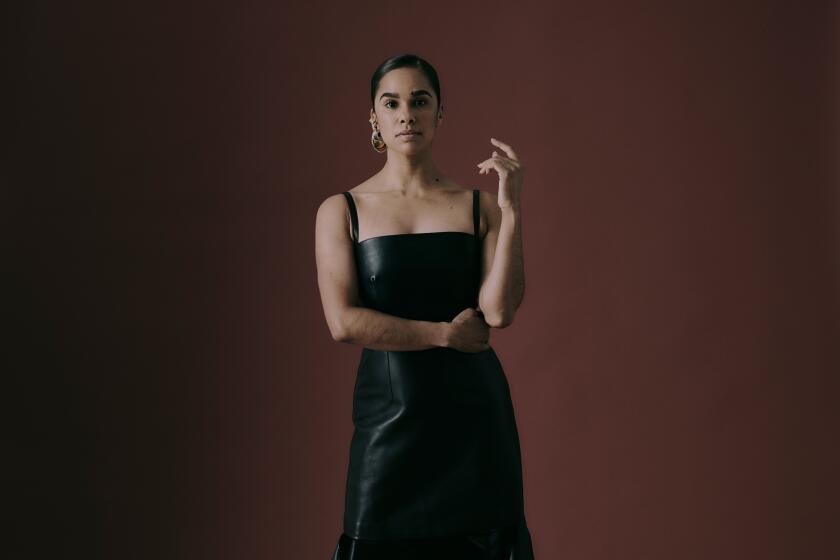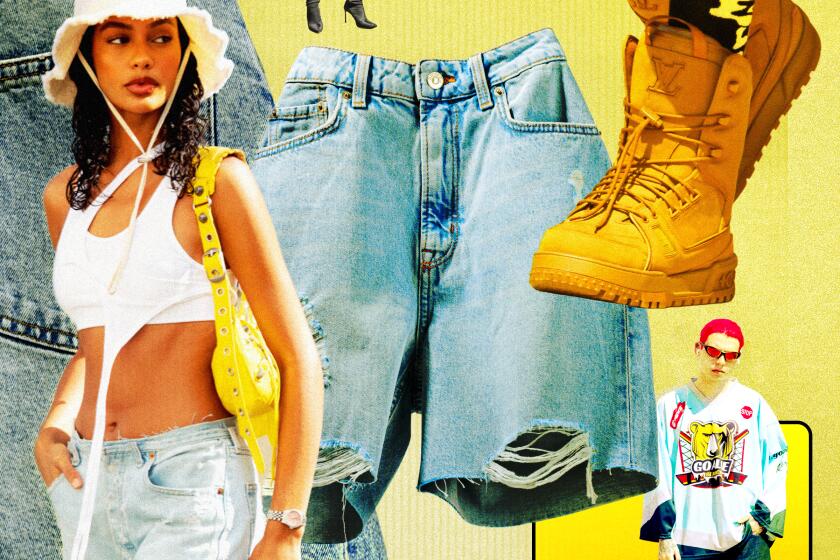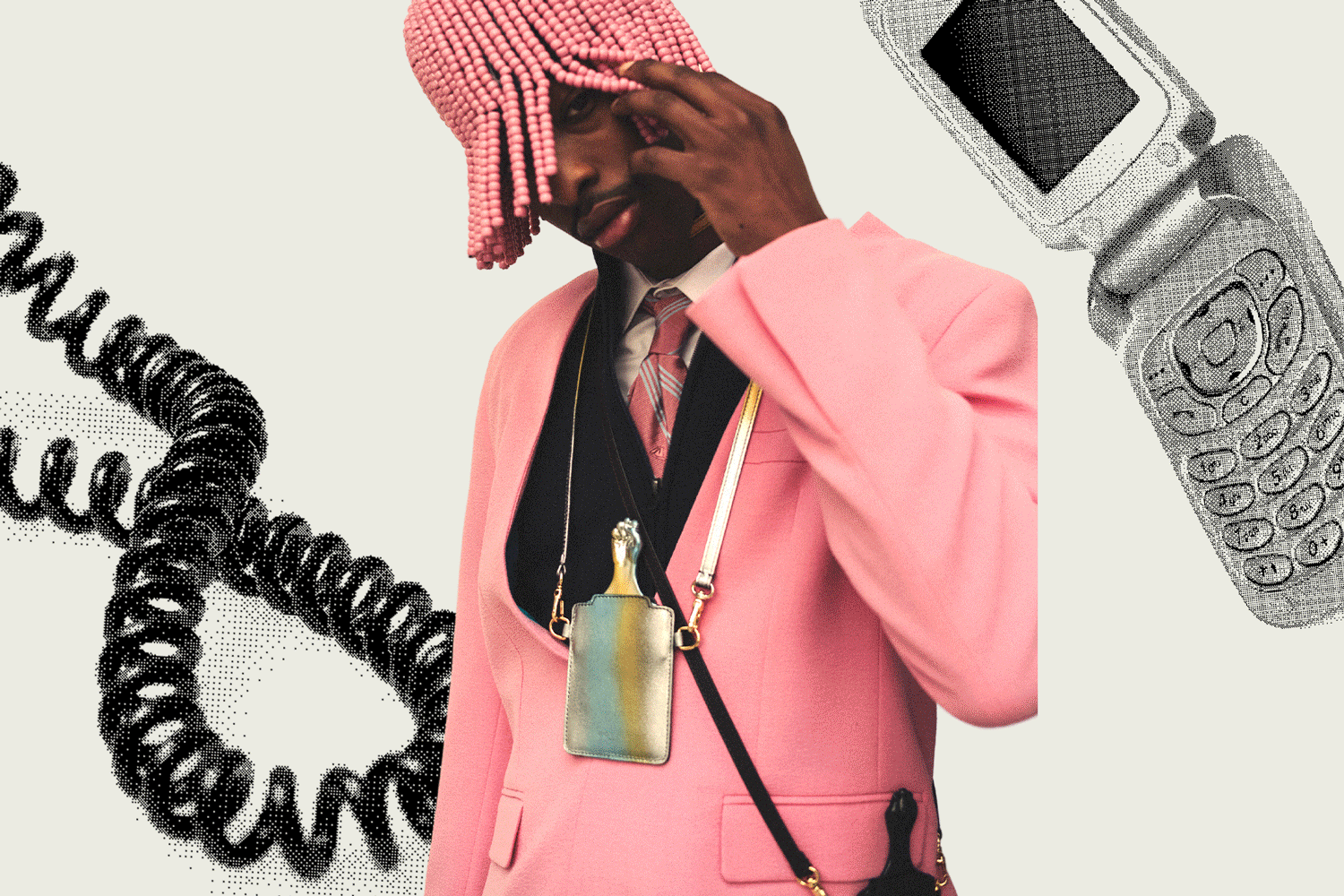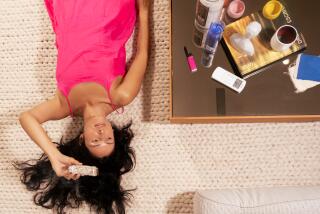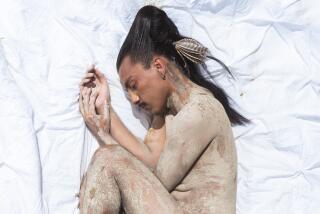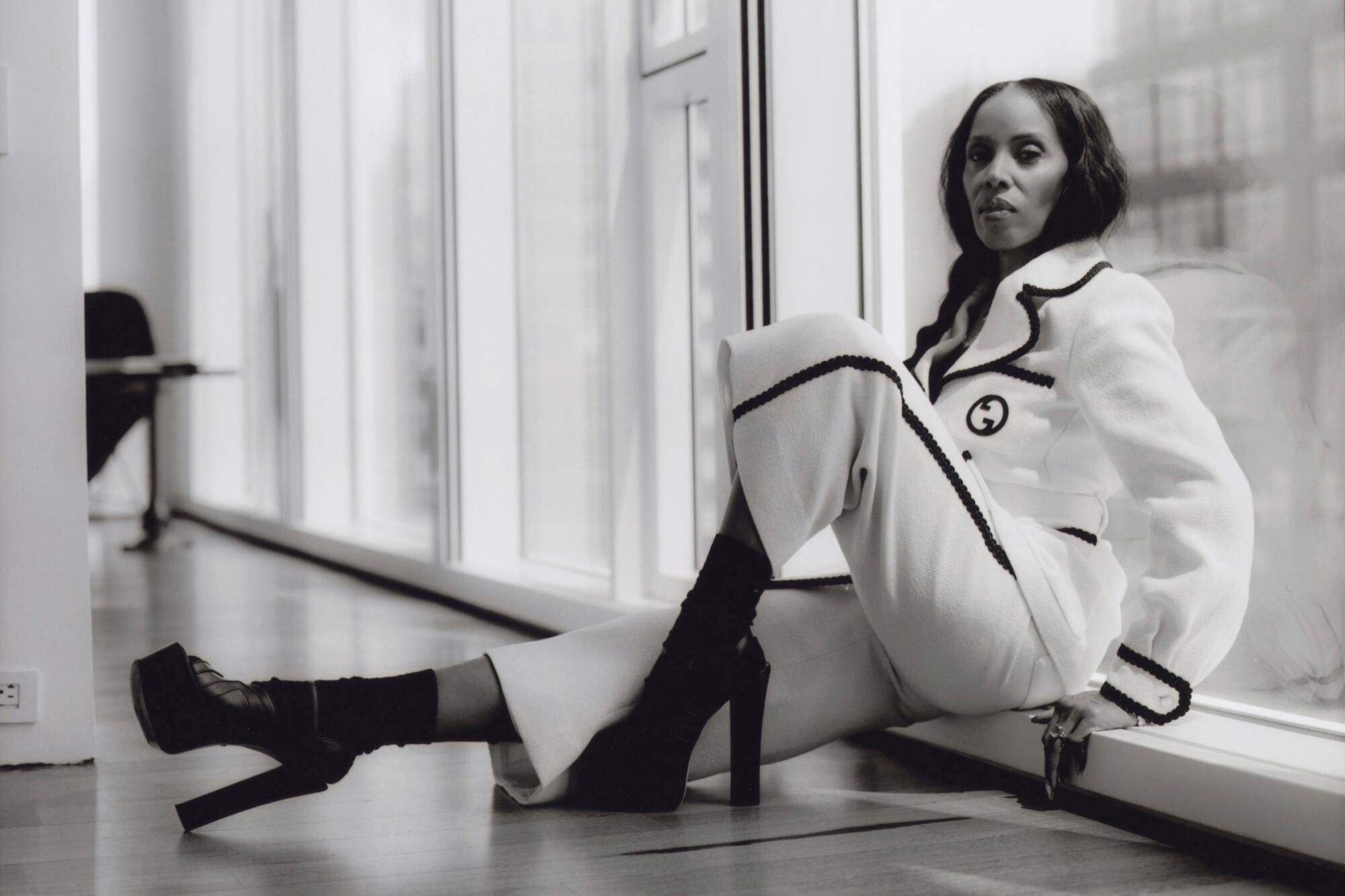
This story is part of “Discourse,” a fresh look at the dire state of the bicoastal conversation — free from corniness and cliches. Check out the whole issue — the “New York” issue, if you’re reading between the lines — here.
On a recent morning in midtown New York City, June Ambrose is sitting in the clouds when she jokes about feeling like the Wizard of Oz. We’re up in the Centurion Lounge, staring out at a hazy urban panorama from somewhere around 55 stories above rain-soaked streets, but Ambrose is speaking even more metaphorically.
For nearly 30 years, she’s been something of a music industry secret weapon — if there’s a music video that immediately comes to mind as “iconic,” odds are Ambrose designed for the artist. Her credits are staggering, her influence palpable in some of hip-hop and R&B’s most memorable style moments: Missy Elliott’s inflatable suit in the video for “The Rain (Supa Dupa Fly).” Jay-Z’s crisp linen look in “Feelin’ It.” Busta Rhymes’ Carnival-inspired aesthetic in “Put Your Hands Where My Eyes Could See.” The list of her creative contributions across disciplines could fill this page and then some, but Ambrose says she never approached her craft with the hope of being recognized. “You don’t see the Wizard,” she says with a characteristically boisterous laugh. “But you knew somebody was behind the curtain.”
The groundbreaking ballerina who’s spent decades making history at the prestigious American Ballet Theatre is showing why institutional knowledge is a forever practice.
We talked about the limits of the word “stylist,” what it’s been like for the multihyphenate to shape the course of both music history and modern fashion, and her latest role as Puma’s creative director for women’s basketball. Our conversation has been condensed and edited.
Hannah Giorgis: You just came back from Paris, where you attended Pharrell’s Louis Vuitton show on the Pont Neuf. How was that trip?
June Ambrose: It was what you see on social times 10. It felt like the royal wedding. Like the coronation of a new guard coming in. They spared no expense. They never close that bridge. To close that not only took money but it took … as much clout as us shooting a music video in the Louvre overnight like we did for “Apes—.”
HG: Who else was there?
JA: I mean, who wasn’t? Zendaya, Jay, Beyoncé, Rihanna, Rocky, Lenny Kravitz. Skepta. The list was heavy.
HG: What did you wear?
JA: I ended up wearing “quiet luxury” by Louis Vuitton. Comme des Garçons was my day look. And then, that evening, I started off with a leather oversized mini-dress with big pockets and a gigantic waist belt. That evening, I wore this jacquard mini-dress that had sequins; it was like a babydoll dress. With the combat boots. It was really fun. I had a ball.
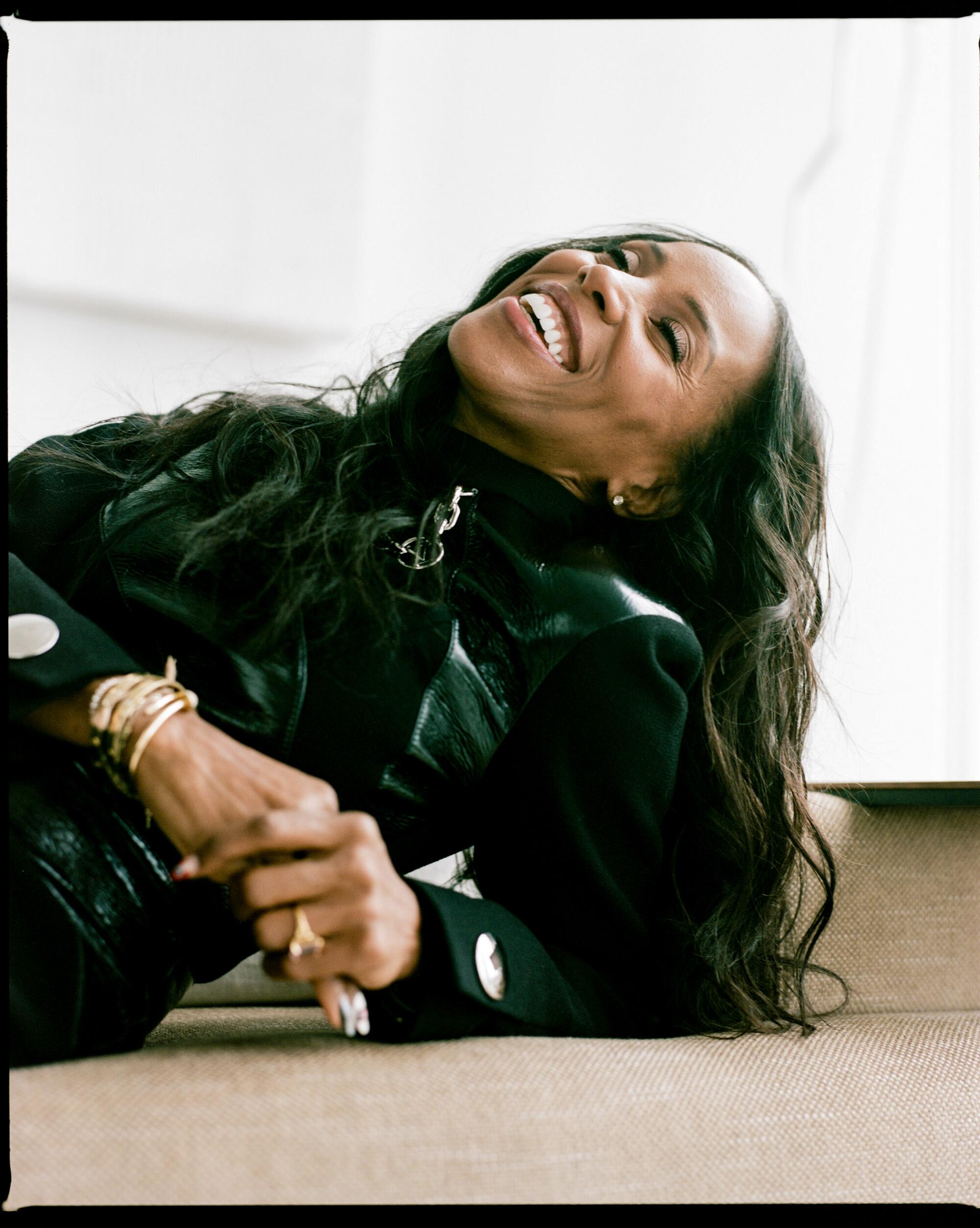
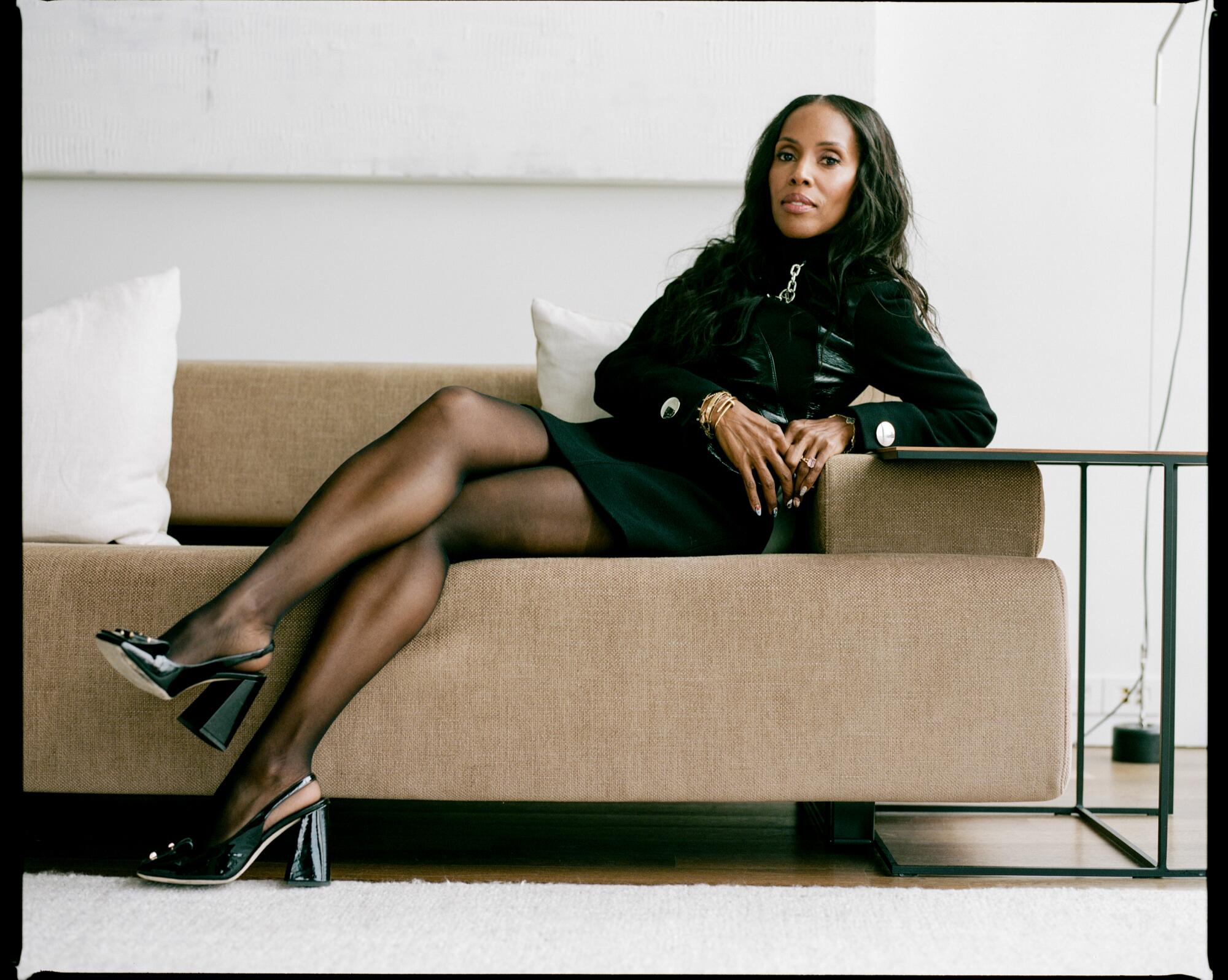
HG: And what are you wearing today?
JA: I’m wearing Sacai. I’m wearing my Junya Watanabe Mickey skirt. My Comme jacket. My Margiela shoes — my Tabis. And my Off White Virgil hat, runway.
I love anything that makes my face look tiny. It’s a trick. I like to play with scale. I’m like an animated version of myself. These silhouettes and shapes make me feel like a little girl. I really tap into sense memories of childhood. What did I feel the most effortless in? What did I feel the most useful in? What made me want to dance?
That’s how I help people to find themselves or reinvent themselves — by reminding them that it’s okay to ask their young selves for permission to feel a certain way. Fashion is a feeling. Style is a feeling, it’s an emotion, it’s not physical. My approach has always been that. It’s so much more than putting clothes together. You can discover yourself in style. It’s a language that only you can speak.
HG: What are some of the memories from your childhood that you enjoy drawing on?
JA: At a young age, I loved glamour. But also because I grew up in the Bronx, I loved disrupting it. If my mom [got me ready for] church Sunday and [had me in] this really frilly dress, I wanted to wear it with my sneakers, before that was a thing.
I loved things that made me get noticed. I was never the young girl who wanted to disappear. I knew how to attract people. I knew how to get what I want. I was the master negotiator manipulator.
HG: A Geminiiiiii...
JA: Yes, a Gemini! And it worked.
HG: How was your impulse to experiment received in your household as a kid?
JA: I can say this now because I’m a mom. It takes extreme control for parents to not say, “Mmm, I don’t think you should do this,” or “Ooh, maybe.” You want to protect them. [But] sometimes you just have to let your kids figure it out for themselves.
My mom gave me room.
HG: As a mother, has having your kids with you on location over the years expanded or changed how you think about your work creatively?
JA: Yeah. When I had my daughter, [there were] video vixens and all that kind of stuff. I [thought]: We could do more than just put on a pair of hot shorts. I think we need to up this conversation a bit. I would push the envelope to make sure that [their] beauty was seen differently.
HG: How does it feel seeing the sort of cyclical return of an era-defining style that you were instrumental in establishing?
JA: It gives me butterflies. It makes me feel like I did something right in my creative life. People are like, “Oh, people don’t give you your roses.” I don’t — I’m sitting on top of a rose. I’m looking at this beautiful sea of creative people that look like me. You look at the artists now, and you can see that they have more creative license, and they’re not afraid. Even with social media, they’re still taking notes from what we did in the ’90s.
At the time, stylists worked with editorial magazines. I remember an editorial piece, like, “Oh, she’s a music video stylist.” That’s how they would talk about us. Fashion is very cruel. So I’ve never considered myself to be a “fashion girl.” Because I didn’t go into it needing to be accepted by the fashion designers and the houses. I was building my own ateliers and writing my own ticket, creating my own path. I was laser-focused. Because I came from theater, costume design was something that I had studied and understood. That was my point of view.
They are a middle finger to the gods of couture and good taste. But the thrill of the Frankenstein object is that it could be a means of self-expression or a gateway into DIY craftiness.
The fashion houses hadn’t yet even understood that there was an opportunity in the world of urban Black music. We invested in ourselves, we bet on ourselves. We didn’t ask for permission. We just did the work. I was referencing Funkadelic, I was referencing Carnival in the Caribbean, I was referencing things like Japanese animation. I was bringing high-fashion ideas into these really provocative urban silhouettes, oversize. The first suit that I designed for Jay-Z was a linen, soft shoulder — I wanted to go for that Italian, Armani feeling because I knew that he wasn’t a suit kid at the time. He needed something that he could relate to. That’s all about me focusing on the character, and not about the trend, or about, “Oh, this is stylistically happening right now, so let me go and pull this too.”
HG: How do you do that kind of collaborative work to get to the character development?
JA: I walk in and I clear the room, because sometimes you just want alone time and you just want it to be between the two of you. When the rooms are too crowded, sometimes it makes you feel like you need to feed the audience with what they want to see. So I would draw these kind of like clinical, psychological scenarios and be like, “This is not about everyone else. And I’m going to take myself out of this for a second. This is about you. How are you feeling?” When people are like, “Why is she still around? Why is she still relevant?” Because I’m intentional. Because I’m authentic. And I think that’s the magic.
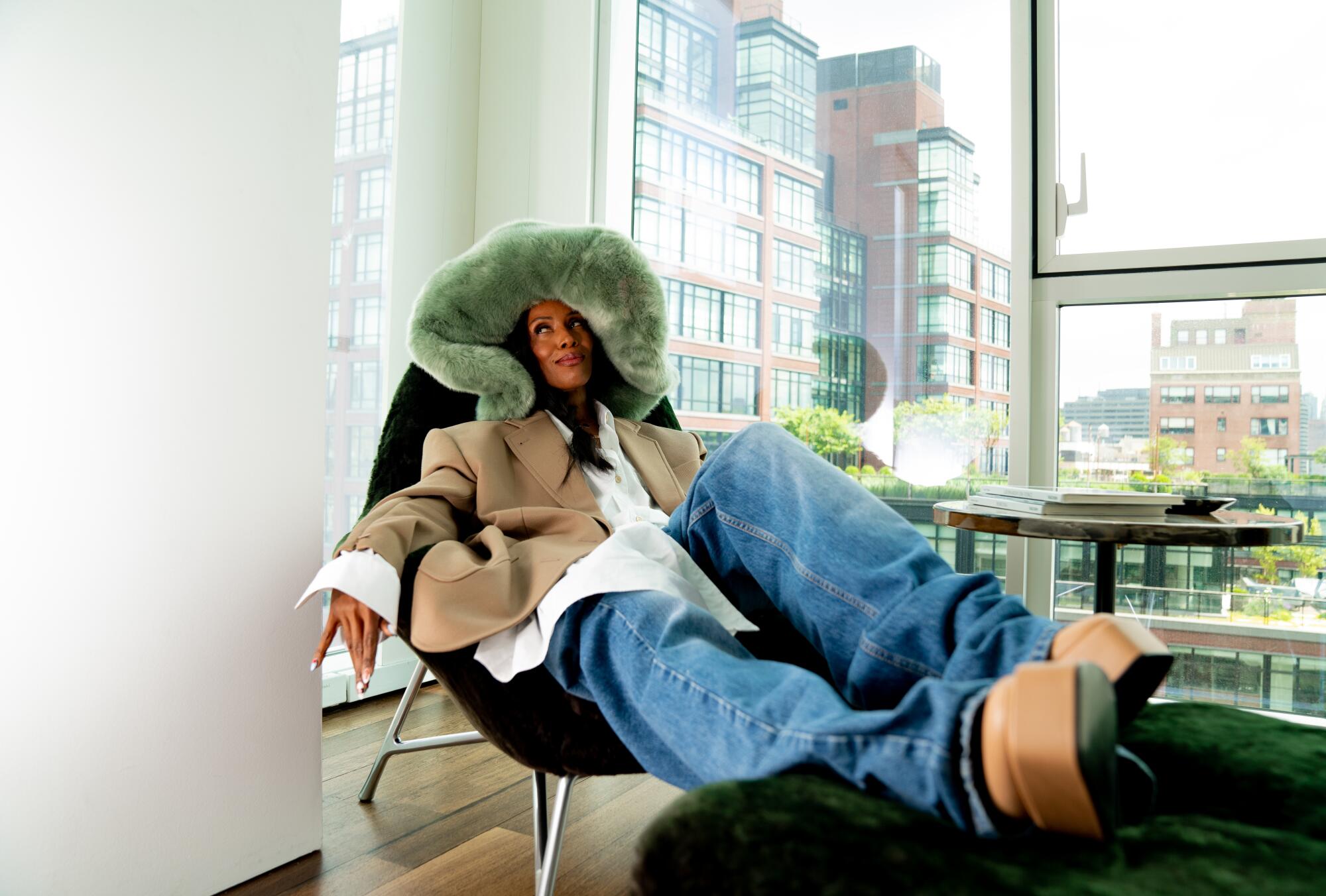
When you walk in as the source of energy, there’s nothing that you can’t take on. When we moved production to the West Coast, and we were doing bigger productions, I was the girl that didn’t hang out at clubs. I was raising the next generation. If you got a chance to work on my team, I was mothering you.
HG: Are there any of those L.A. shoots that feel especially memorable to you looking back at them now?
JA: I remember the Missy Elliott “She’s a B—” video — we shot on a huge soundstage out in Burbank. And we [were] working with prosthetics, and we brought in special effects. And I just remember, I just felt like, I finally made it to Hollywood, I get to do these mini movies.
L.A. also had superior costume houses. We had little costume houses, theater costume houses in New York. L.A. was on steroids. You had lots, and along with those lots, you had these beautiful period pieces. Everything was so well archived. It was superior, just great vintage resources, too, that were really unmatched. I spent a lot of time falling in love with that part of L.A. Hated the traffic, but L.A. also gave me the space to have quiet time, to be still.
HG: What did that quiet do for you, creatively?
JA: It was really good because I got to reconnect with my creativity in a different way. You could take long drives up the Pacific Highway, whereas I couldn’t, I wouldn’t do that in New York. The PCH was a getaway or you go out to drive to Santa Barbara, and it was a different kind of reset, which was really nice, that tranquility.
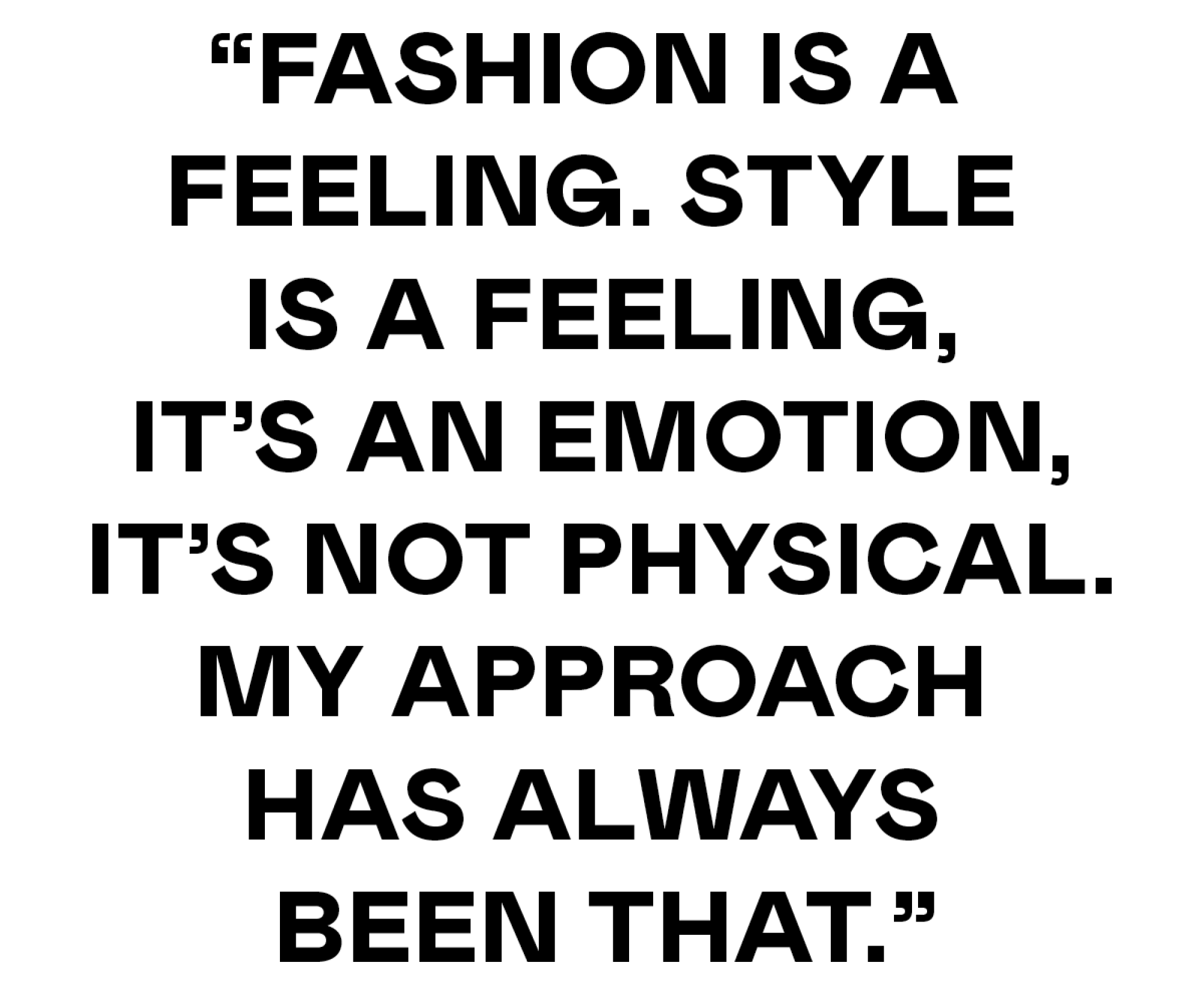
HG: Talk me through your process for different kinds of craft.
JA: When you’re doing the print and the still-life stuff, it feels more like editorial. Then when you’re going onstage, that’s like, real time. You can’t get away with the same things you got away with with editorial storytelling.
And then you have a music video, where you can manipulate things and play with color. When I’m ideating for music videos, I’m always working with my DP [director of photography]. I’m sitting with the glam team, we’re talking, I’m like, “What [could] this hair story [be]? What is that makeup?” I want to know if we’re shooting black and white film, or if the lens is going to be this perspective [or that] — I want to know in terms of texture, in terms of color.
It always starts with the vision board. And then the subject. Their specs, complexion. Whether it was a male or female. I keep a case folder on body types and things that make them itch — do they have sensory issues? I’ve worked with every body type, every nationality, age range, I’ve worked with boy bands. Backstreet Boys. Mariah Carey. Missy Elliot. Pharrell. Icons like Luther Vandross. (The skinny Luther, the full-size Luther.)
Marine Serre’s Silk Scarves Bowling Shirt. Supervsn x Tommy Hilfiger’s “Nu America” jacket. No Sesso’s debut Carry Bag collection. Here’s what to covet this month.
HG: What do you consider your environment, your world? And what do you see as your role, or the space that you occupy, within it?
JA: Such a smart question, because no one asks that. The titles haunt me. My contributions have so many layers — I’ve nurtured and developed and mothered and curated. Is it enough to say, “She styled me?” No, I didn’t just put clothes together for you. Think about what I did. Think about our relationship, think about the work that you’re looking at, think about the art.
I consider myself an artist. So you want to introduce me as something? Introduce me as an artist, then that makes you curious: “Well, what kind of artist are you?” Like, I’ve never walked into a room with any of my celebrity clients and felt like I wasn’t equal to them. Never.
HG: You just work in different mediums. And sometimes in the same medium.
JA: That’s what we do. I entertain. I give you something to look at. So I want you to acknowledge that it’s more than the one word that you put it into. You want to give me my roses, just tell me. Because none of it was easy. And I’ve made tremendous amounts of sacrifices, and it’s lonely. And there are many times that I’ve felt lonely, and creating is very exhausting. It’s why designers take vacation after putting a collection out.
When I did [the Puma runway experience] Futrograde [for New York Fashion Week in 2022], after having designed 50 looks for the runway, I was depleted. After every music video, any job I do, I’m literally depleted. And I need a reset, I need an LV bag. I need to hydrate — physically, metaphorically. And if you speak to an artist, and you ask them, “How do you feel when you come off the stage?” They would explain it in the same way.
HG: What does it mean to you to bring the level of imagination and artistry that people associate with you to the sports world?
JA: When I took on the role as Puma’s creative director, for me, that was such a fun challenge. Building these star iconic moments over the years in my career takes thinking, it takes navigating, it takes thoughtfulness.
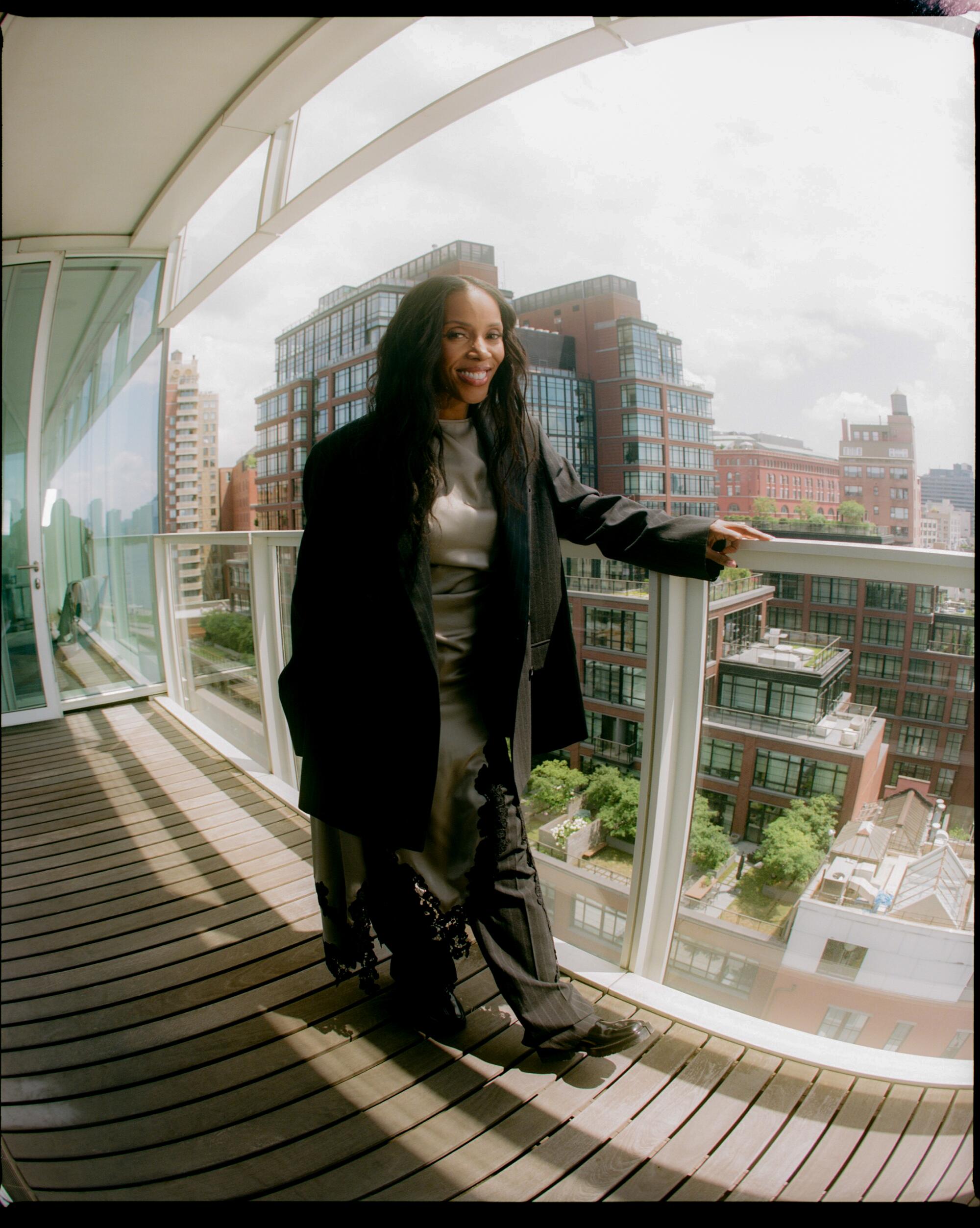
HG: What are you most excited about in terms of what you have coming up in the future?
JA: I continue to reinvent myself, reimagine what my life could be. I’m still on this journey. I wake up every morning just so excited, curious to know what’s next. I like to speak things that I want into existence, I like to call on it, both verbally and spiritually. I write things down. I say it because I think to be intentional about what you want is really important in this life. Everyone’s kind of reaching toward the same, but I know one thing that I do have is the experience. I have the experience. I did it. And I’m willing to do it again and again and again. And I want to do it with an army of people that get me and get it. It’s coming.
Makeup: Renee Sanganoo
Hair: Chaise Enrique
Hannah Giorgis is a California-born writer living in New York.

